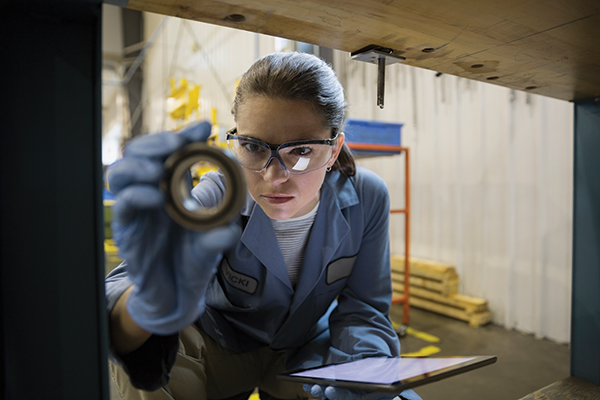Meet Alice, the Next Generation Energy Field Worker.
On a cold, rainy morning, Alice reaches for her waterproof tablet and sees that she has 15 stops for the day. After arriving at her first stop, she heads to the customer’s door with her tablet and tool bag. While the customer is not home, she quickly finds their contact information and notifies them she is on site. She uses an asset map on her tablet to guide her to the exact location of the meter on the premise. Once the meter is replaced, the meter details are updated with a quick scan using her barcode scanner. The customer returns home, and using the built-in credit card reader on her tablet, Alice can collect payment. Within seconds, the customer’s transaction is complete and a confirmation text message is sent. Alice even records a quick comment on the work order using the tablet’s speech-to-text feature.
The beauty of this workflow is that Alice could deliver top-of-the-line customer service quickly and efficiently. She was connected and equipped with the right tools and information to complete her work at the field site – no paperwork, no typing.
Tablets and smartphones are fundamentally improving utility field operations, as these lightweight, powerful and intuitive devices are perfectly suited for seamless integration into on-the-go field operations. So, how can utilities unlock the full potential of tablets and smartphones and ensure a successful deployment with maximum benefits? The key for digital utilities is to rethink their current business workflows, enable the right ecosystem for the new devices, and effectively manage the change.
For example, utilities can reimagine their business workflows in the following ways:
- Optimize work scheduling and routing by allowing a field worker to navigate to the site directly with a single click from their work management solution. When used with a work scheduling system, they can provide real-time location visibility to schedulers and foremen.
- Improve workforce safety with a “Lone Worker Alert” system. Where there are safety concerns, using the app, the lone field workers would notify a dispatcher, providing GPS location and timeframe. The app will alert the dispatcher if the worker fails to check-in within the alloted timeframe.
- Introduce intrinsically safe tablets and smartphones, especially in hazardous environments, to enable seamless technology-based workflows and optimize operations.
- Utilize complimentary device add-ons to optimize operations further and enable a better customer experience. Integrated barcode scanners can automate meter scanning at field sites and improve inventory management at asset depots. Mobile devices can be used with integrated credit card readers, thereby creating a full PoS (Point-of-Sale) solution for collecting payments.

Understand Field Workers’ Needs and Establish the Right Device Ecosystem
Every field group is unique in its operations and has different mobility needs. For example, first responders handling emergency situations value weatherproof capabilities and a large screen to view asset maps on the go, while field collection agents making 25-30 stops a day value portability and integrated card readers to collect payments. And meter journeymen investigating meter issues need multiple device ports to connect and test field equipment. Understanding the real field worker mobility needs and deploying the right device ecosystem is critical to obtaining the most value out of these devices.
Throughout the mobility journey, utilities have to make several selections that define the capabilities delivered as well as end user experience. These decisions must be based on the mobility needs of the field workforce as well as the firm’s existing enterprise infrastructure. For example, the application needs of the field worker as well as the firm’s platform capabilities are strong drivers for the OS/platform selection. Similarly, the field worker’s everyday work environment (number of stops per day, outdoors vs. indoors, emergencies vs. regular support) dictates the ruggedness of the device and the form factor (smartphone vs. tablet).
In addition, there are several mobility considerations that are foundational for tablets and smartphones but are often overlooked, especially when migrating from laptops. These include:
- Network connectivity: Cost of new data plans, handling network signal drops/reconnects, enabling offline mode of operations for remote areas
- Mobility lifecycle management: Mobile Device Management (MDM) software, initial provisioning and final decommissioning processes, helpdesk training for supporting new devices
- Cyber considerations: Steps to manage risks from additional mobility including new usage policies and remote device controls
Managing Change Is Critical
A one-size-fits-all change delivery approach never works when deploying mobile devices to multiple field workforce groups. Any change delivery approach should be firmly rooted in the operations they perform and the associated challenges that entail. In addition, the change journey and the associated training elements are very different when first deploying mobility to transition from paper-based workflows than when migrating from existing laptop-based electronic workflows.
To achieve success with change management, utilities need to consider the following tips:
- Always run a pilot deployment to gather field user feedback and catch issues early, before an enterprise wide deployment.
- If the tablet/smartphone deployment is part of the utility’s broader field work modernization effort, decouple the device deployment from the workforce mobility solution deployment to reduce the amount of change inflicted upon the field worker.
- Get it right the first time by preempting the key operational challenges. For field workers who are constantly on the move and need instant access to accurate information, integration and connectivity challenges are the most important factors to ensure smooth operations.
- Ensure support staff preparedness for new platforms, workflows and capabilities. Since tablets and smartphones are mobile and provide fundamentally different interactions through touch-sensitive user interfaces, the support issues are often very different from that of laptops.
Engage Key Stakeholders
Deploying mobility solutions does not occur in a vacuum. Bring the business and IT stakeholders along in the decision-making process to keep them engaged and on board. This becomes even more critical with tablet and smartphone deployments because these devices are new to business operations, and takeholders may not be fully aware of their transformative power to drive efficiency and productivity increases in the field.
Looking Ahead
The case for mobile device adoption is powerful. It allows Alice to streamline her work, ultimately providing better service to her customers. However, these devices create new capabilities, usage models, and training requirements – all of which need careful consideration and planning. Digital utilities can position themselves for success by maximizing the value of these ultraportable, uber-connected devices by rethinking business workflows, establishing the right ecosystem (tools, infrastructure, and support), and effectively managing the change.
 Ajay Jawahar is an energy and utilities expert at PA Consulting Group focused on delivering digital business transformations and end-to-end technology/strategic solutions. He has several years of experience working on utility field operations, specializing in areas around mobile workforce management, GIS and outage management.
Ajay Jawahar is an energy and utilities expert at PA Consulting Group focused on delivering digital business transformations and end-to-end technology/strategic solutions. He has several years of experience working on utility field operations, specializing in areas around mobile workforce management, GIS and outage management.
 Jamison Roof is an energy and utilities expert at PA Consulting Group. He specializes in digital field work transformations and has delivered large scale system integration and implementation projects for over 18 years.
Jamison Roof is an energy and utilities expert at PA Consulting Group. He specializes in digital field work transformations and has delivered large scale system integration and implementation projects for over 18 years.
 Elizabeth Metzger is a digital transformation expert at PA Consulting Group focused on delivering operational and strategic value in large scale business transformations. She is an Agile expert and has helped clients deliver results using Agile, waterfall, and hybrid methodologies.
Elizabeth Metzger is a digital transformation expert at PA Consulting Group focused on delivering operational and strategic value in large scale business transformations. She is an Agile expert and has helped clients deliver results using Agile, waterfall, and hybrid methodologies.







